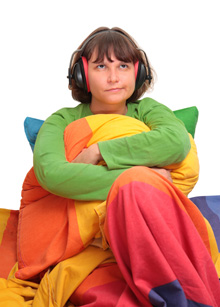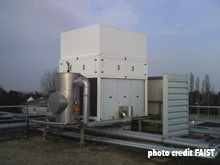Equipment noise, which must be limited to not impair acoustic comfort, is regulated in many constructions, by setting limits for the value of the normalized sound pressure level LnAT of the noise which is attributable to them (for a reverberation time equal to 0.5 s in the reception room). ITS offers acoustic measurements, diagnosis of equipment noise, and also soundproofing equipment to avoid noise pollution.

equipment noise |
Equipment noise for constructions covered by the Order of 30 June 1999 relating to their acoustic characteristics
In residential buildings:
- for noise generated by an individual heater or individual air-conditioning unit in a dwelling, this level shall not exceed 35 dB (A) in the main rooms and 50 dB (A) in the main room. kitchen of this accommodation; however, when the kitchen is open on a main room, this level, for an individual heater of the dwelling operating at minimum power shall not exceed, in the main room on which gives the kitchen of this dwelling: 45 dB(A) , for dwellings that have been the subject of an application for a building permit or a declaration of works relating to the elevations of old residential buildings and the additions to such buildings, submitted between 1 January 2000 and 31 December 2000 and 40 dB (A) as from 1 January 2001
- for noise generated by a mechanical ventilation installation in a minimum flow position, this level must not exceed 30 dB (A) in the main rooms and 35 dB (A) in the kitchens of each dwelling, including the outlets
- for noise generated by individual equipment of a dwelling of the building this level shall not exceed 30 dB (A) in the main rooms and 35 dB (A) in the kitchens of the other dwellings
- for noise generated by collective building equipment, such as elevators, heating boilers or substations, transformers, water boosters, garbage disposal, this level shall not exceed 30 dB (A) in the main rooms and 35 dB (A) in the kitchens of each dwelling
Equipment noise for constructions covered by the decrees of 25 April 2003 relating to the limitation of noise
In educational institutions (regarding equipment noise):
- for noise generated in libraries, documentation and information centers, medical premises, infirmaries and rest rooms, music rooms by an equipment related to the building, this level shall not exceed 33 dB (A) if the equipment operates continuously and 38 dB (A) if it operates intermittently; these levels are increased to 38 and 43 dB (A) respectively for all other reception areas
In hotels (regarding equipment noise):
- for noise generated in the rooms by an equipment, whether collective or individual, related to the building, this level must not exceed 30 dB (A); this value is raised to 35 dB (A) when the equipment is installed in the room (heating, air conditioning)
- for noise generated in an accommodation premise by an equipment related to be building and located outside this room, this level must not exceed 30 dB (A) in general and 35 dB (A) for hydraulic and sanitary equipment in neighboring accommodation premises
In health facilities (regarding equipment noise):
- for noise transmitted by the operation of a collective equipment related to the building this level must not exceed the following values: in examination and consultation rooms, medical and nursing offices, waiting rooms: 35 dB(A) ; in treatment rooms: 40 dB(A); in operating theaters, obstetrics and workrooms: 40 dB(A)
Equipment noise : measurements, diagnosis and soundproofing hardware offered by ITS
To quantify equipment noise, and assess whether there is sound disturbance for the occupants of a building or for neighbors, ITS can carry out acoustic measurements on site:
- in technical rooms
- near outdoor facilities
- on the property line
- in complinants home
These metrological interventions, carried out by a human resource employed by ITS (duly qualified in physical measurements, specialized in instrumental techniques), are the basis of the diagnosis carried out by ITS in terms of equipment noise, necessary to provide advice and define orientations in terms of improving the situation, when necessary (a study can then be carried out by an acoustic engineer from ITS, often involving noise transmission calculations and acoustic propagation modeling).
The recommendations made by ITS in the context of equipment noise reduction are based on long experience in the field of acoustical consultancy and soundproofing engineering, take into account all the elements of the context and constitute reliable, detailed, precise ways for progress, accompanied by a verifiable result objective and an estimated cost.
ITS can also offer soundproofing hardware to avoid noise pollution from noisy equipment for the occupants of a building or for its users. To limit the noise of Heating Ventilation Air Conditioning (abbreviated HVAC) equipment, (which often involve pumps, compressors, fans, boilers, air conditioners but also air condensers/air coolers, refrigeration units and heat pumps) and also generators, ITS often offers silencers, and cowlings (acoustic screens are considered in the case of equipment installed outdoors).
Spread the word !

(air conditioning) equipment |